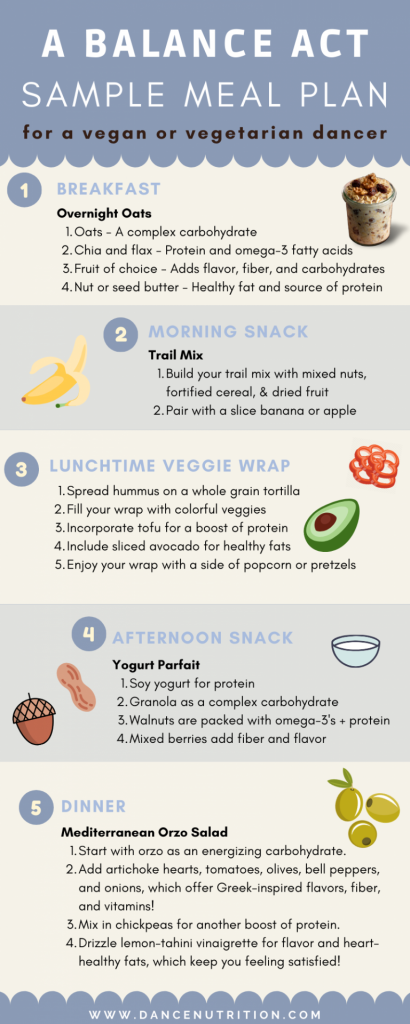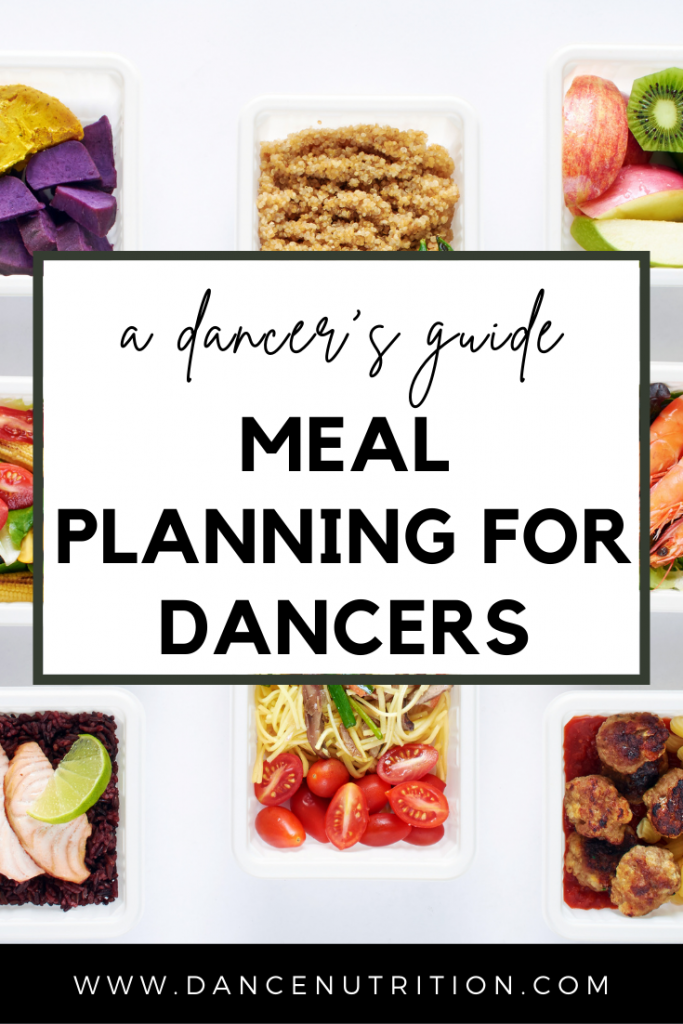Meal planning can help dancers build a supportive routine for their busy schedules. Dancers who meal plan are more likely to fuel sufficiently, reducing their risk of under-fueling and injury. But what does meal planning look like, and, how can dancers learn how to meal plan sustainably?
In this guide, we’ll break down how to effectively meal plan for your schedule, focusing on the key nutrients dancers need, how to create balanced meals, and tips to maximize your meal plan efficiency.
Why Is Meal Planning Important for Dancers?
As a dancer, your nutritional needs are comparable to those of an athlete— long hours of practice, high-intensity movements, and the physical strain on your muscles and joints. Without consistent energy and a running supply of nutrients, you’ll risk injury, fatigue, and burnout.
Busy schedules and above-average training loads, however, are leading contributors to a dancer’s risk of unintentional under-eating. Meal planning offers reliability and structure, ensuring those nutritional needs are met.
The same holds for dancers with a history of restrictive eating. Meal planning provides external structure when interoceptive awareness (innate hunger/fullness cues) is diminished or unreliable. Years (even months!) of restrictive eating can damage our ability to feel and honor hunger. Creating a flexible meal plan assures you’re meeting your body’s primitive needs for nourishment.
What’s Involved?
Meal planning involves setting time aside to plan your day’s or week’s meals and snacks. It offers structure, intentionality, organization, and preparation so you’re eating enough while maximizing your food choices. For some, planning a week’s meals and snacks helps ensure certain foods and ingredients are on hand— a time and money saver.
Meal Planning vs. Meal Tracking:
Unlike meal planning, meal tracking involves recording what you eat for analysis and reflection. I’ve previously discussed how the latter can be a helpful tool for dancers but runs the risk of becoming obsessive.
Ask yourself: is your focus on adding or taking away food? Meal planning can help you proactively fuel, but if your goal is less about sticking to meal patterns and more about following rigid food rules, then reassess. A sign of disordered eating is the feeling of overwhelming scrutiny upon your daily food choices
Healthy Meal Plans: Start Now
As a dancer, your approach to meal planning is individual. You can start by picking one meal or a few snacks to plan for the day. If you struggle to remember snacks, consider what’s packable and convenient (examples below). If you can’t wake up in time for breakfast, try a portable alternative. This intention will be an integral first step in utilizing meal planning to optimize your dance training. From there, consider these three steps:
#1: Remember Flexibility
There’s a difference between meal planning and downloading a meal plan. Caution with downloadable meal plans that dictate what you can (and cannot) eat. Rather, build a flexible framework that reminds you to nourish consistently throughout the day. Remember, life happens. We cannot control every aspect of our schedule.
You’ll also want to assess whether or not you are choosing foods because you genuinely enjoy eating them or because you’ve heard they’re “healthy” or “good.” Often, but not always, people choose foods because they “think” they’re what they “should” be eating. This can drive you further away from finding true satisfaction. Learn more about food flexibility here.

#2: Consider Variety
When planning meals ahead of time, you can ensure you’re eating a wide variety of foods. Consider your preferences and stock your pantry with versatile options. Examples include whole grains, veggies (frozen or fresh), fruit (frozen or fresh), dairy (unless intolerant), and other proteins (like beans, legumes, nuts, poultry, and meat). Here’s an article that dives deeper into food variety for dancers.
#3: Plan for Emergencies
This is often the bulk of the meal planning that I do with clients. Emergency snacks help to manage long time stretches. Coordinate daily snacks as a means to stabilize blood sugar between meals. Here’s a list of staples to add to your meal planning checklist:
- Handheld fruit (like oranges, bananas, and apples) are convenient and budget-friendly.
- Jerky or string cheese offers an easy protein source.
- Nut butter squeeze packs are easy to make and pair with a piece of fruit or pretzels.
- Crackers or pretzels can be portable.
- Dried edamame is a balanced option for plant-based (and non-plant-based) dancers.
- Trail mix can be eaten on its own or added to oatmeal, yogurt, or salads.
- Dark chocolate-covered almonds are an awesome sweet treat rich in magnesium and fiber.
- Popcorn is a fibrous whole grain and easy to pack.
- Fruit Squeeze packs offer quick energy between classes.
- Fruit-based bars contain naturally occurring fats to satisfy your hunger between meals.
Sample Meal Plan for Dancers
This sample meal plan is designed to provide dancers with the energy to fuel training, support muscle recovery, and stay focused throughout a busy week. Each day includes balanced meals and snacks, with a focus on carbohydrates for energy, protein for muscle repair, and fats for joint health and hormonal balance.
Breakfast: Oatmeal with almond butter, banana (sliced), and a mix of chia and flax. Pair with a yogurt and granola. Meal planning tip: Overnight oats can be prepped in advance and saved for a few days.
Mid-Morning Snack: 1 apple paired with trail mix. Meal planning tip: make snacks convenient and portable.
Lunch: A wrap, filled with chicken (or tofu), quinoa, lentils, and a variety of veggies. Include a vinaigrette-based dressing. Serve with chips or pretzels. Meal planning tip: pre-season your protein or rely on last night’s leftovers.
Afternoon Snack: almond butter and jelly sandwich on sourdough, paired with a banana. Meal planning tip: handheld fruits like apples and bananas are best for busy days.
Dinner: stir-fry: protein of choice, scrambled egg, mixed veggies (carrots, corn, snap peas, broccoli), and brown rice sautéed with sesame oil and soy sauce. Complete with your favorite dessert.
Evening Snack: A homemade smoothie.
Meal Planning: Key Takeaways
Let’s say you’re navigating an afternoon of classes, followed by rehearsals and a list of emails to respond to. Before you know it, it’s 8 PM and you’re ravenous. Your schedule didn’t lend time for a break, so now, you’re scrambling to fill your gnawing hunger.
This scenario is today’s reality. Meal planning is an essential tool when navigating a busy schedule. Remember, we’re building habits that are not only balanced but are also practical (and sustainable). Here’s a quick list to get you started:
- Start with consistency: plan for at least 3 meals and 2 snacks.
- Prioritize balance: this involves the 3 macronutrients at each meal and snack: protein, fat, and carbohydrates.
- Scan your body for feedback. Notice your fullness cues and when they begin to kick in. How’s your energy in class and after eating certain foods? Journal and reflect.
- Always remember food flexibility.
- Skip the comparative mindset. The amount of food your body needs will not be the same for another dancer.




